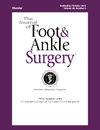Impact of preoperative pes planus on orthopaedic implant removal following first metatarsophalangeal joint arthrodesis: A retrospective analysis
IF 1.3
4区 医学
Q2 Medicine
引用次数: 0
Abstract
First metatarsophalangeal (MTP) joint fusion is a frequently employed surgical treatment option for hallux rigidus and hallux valgus. Implant-related complications are common, necessitating further investigation into predisposing factors. The altered mechanics of pes planus may influence surgical outcomes; however, its direct impact on implant removal rates post-fusion remains unclear.
We retrospectively analyzed the TriNetX US Collaborative Network database to identify patients undergoing first MTP joint arthrodesis by ICD-10 and CPT coding, the data was stratified by preoperative pes planus status. Implant removal rates were compared between pes planus (PP) and non-pes planus (noPP) cohorts. Odds ratios (OR) were calculated to assess associations.
Patients in the PP cohort exhibited significantly higher rates of subsequent hardware irritation (OR 1.30, 95 % CI 1.010-1.675), and hardware removal (OR 1.27, 95 % CI 1.007-1.604) compared to patients in the noPP cohort.
Our findings highlight patients with preoperative pes planus have significantly increased likelihood of implant irritation, removal, and reoperation following first MTP joint arthrodesis surgery. Biomechanical alterations associated with pes planus likely contribute to accelerated implant wear and compromise fusion stability leading to higher rates of future surgery.
术前平足对第一跖趾关节融合术后骨科植入物取出的影响:回顾性分析。
第一跖趾(MTP)关节融合术是治疗拇趾僵硬和拇外翻的常用手术方法。种植体相关的并发症是常见的,需要进一步调查诱发因素。平足的力学改变可能影响手术结果;然而,其对融合后种植体移除率的直接影响尚不清楚。我们回顾性分析TriNetX美国协作网络数据库,通过ICD-10和CPT编码识别首次接受MTP关节融合术的患者,并根据术前平足状态对数据进行分层。比较扁平足(PP)组和非扁平足(noPP)组的植入物移除率。计算比值比(OR)来评估相关性。与noPP组相比,PP组患者表现出明显更高的后续硬体刺激率(OR 1.30, 95% CI 1.010-1.675)和硬体移除率(OR 1.27, 95% CI 1.007-1.604)。我们的研究结果强调术前扁平足的患者在首次MTP关节融合术后植入物刺激、移除和再手术的可能性显著增加。扁平足相关的生物力学改变可能会加速假体磨损,损害融合稳定性,导致更高的未来手术率。
本文章由计算机程序翻译,如有差异,请以英文原文为准。
求助全文
约1分钟内获得全文
求助全文
来源期刊

Journal of Foot & Ankle Surgery
ORTHOPEDICS-SURGERY
CiteScore
2.30
自引率
7.70%
发文量
234
审稿时长
29.8 weeks
期刊介绍:
The Journal of Foot & Ankle Surgery is the leading source for original, clinically-focused articles on the surgical and medical management of the foot and ankle. Each bi-monthly, peer-reviewed issue addresses relevant topics to the profession, such as: adult reconstruction of the forefoot; adult reconstruction of the hindfoot and ankle; diabetes; medicine/rheumatology; pediatrics; research; sports medicine; trauma; and tumors.
 求助内容:
求助内容: 应助结果提醒方式:
应助结果提醒方式:


